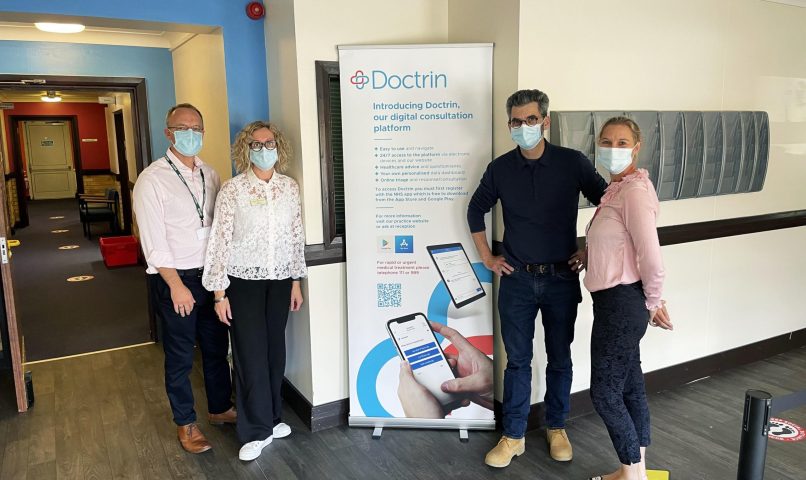
5 Key Success Factors When Digitalising Healthcare
Digitalisation is much more than adding technology. Digitalisation is using technology to redesign improved working methods, patient flows and forms of communication and collaboration. Unn Hellberg, who leads Doctrin’s customer team, has been responsible for implementing close to 200 care units in both primary and specialist care. Here, she shares success factors and pitfalls to avoid when digitalising healthcare.
Unn, what would you say characterises a successful digitalisation journey?
For me, successful digitalisation is when a digital tool becomes an enabler for creating value and achieving goals in the business. This can be in the form of increased accessibility for patients, improved working environment for healthcare staff, improved collaboration, increased quality, increased efficiency, e.t.c. We always start the conversation with the customer by stressing the importance of having clearly defined goals and emphasising the need for changed working methods when implementing a digital tool, in order to get real and long-term business benefits.
Other distinguishing factors are:
- Strong local ownership. This means that the clinical and management team has a clear picture of the objectives and takes full responsibility for driving change in that direction.
- Mapping existing problems and challenges digitalisation can alleviate and set up concrete KPIs (Key Performance Indicators) to follow development continuously. Because digitalisation means that we can follow developments in real-time data, an analytics dashboard can also be used as a tool for including and enthusing employees and getting everyone involved in the change journey.
- Design process which includes the patient perspective to produce a patient-centric platform. The process needs to include helping patients understand why you are making this change and how it will be better for them, it needs to facilitate the patient interaction, making it easy to contact and communicate with you in this new digital way including via your existing channels such as website or telephone services.
- Involve all employees in the organisation in the digitalisation journey representing each profession and role working together to define new routines and working methods. It is also essential that employees influence how digital solutions are designed and adapted to the locality specific business so that they become a useful tool that facilitates day to day operations.
- Continuous improvements and evaluation of working methods through listening and responding. The healthcare providers that achieve the best results adjust their working methods based on data and feedback from the patients and employees using the system to continuously find new and better ways to work digitally.
The opposite of successful digitalisation is when the digital systems are perceived as a disruption and placed as another layer or “another system”, on top of the business without being anchored in it. There are several reasons, the commonest ones being :
- Attempts are made to insert digital tools without developing existing working methods or ways of communication and collaboration. This limits the effectiveness of the implementation and results in limited and slow improvement dampening enthusiasm and the motivation, after which it is difficult to regain momentum and the appetite for change.
- Insufficient time is set aside for preparation and training. Despite feedback that our digital tools are not challenging to use, we know that for most people, change is associated with a certain amount of stress, especially when you are already working under very high pressure. Therefore, time is needed to introduce employees to new ways of working and then continue to provide scheduled space for digital consultations amongst the regular business. We have seen that the time the organisation invests in preparation and inclusion is recouped several times over in the future.
What do you usually recommend healthcare providers to think about who are at the beginning of their digitalisation journey?
In addition to carefully thinking through their goals and how to communicate them to get the employees involved, my main recommendation would be to identify who could be ambassadors for digitalisation.
We advise against, forcing all employees to start working in the platform immediately as some will be resistant. Instead, let those who are curious and positive start to develop routines for new ways of working. Those who are already enthusiastic, often have a greater understanding that there will be a need to refine the approach, which creates and develops a learning and innovative organisation and gets positive results faster. Seeing the benefits of introduction will then encourage the skeptics to get onboard.
What can customers expect from Doctrin during the digitalisation journey?
We offer a proven implementation method with templates and structures to take our units from the initial introductory meeting to the first patient entering the platform and then ongoing support. The fact that we have made over 200 implementations in many different types of organisations means that we can adapt our methods to the customer such as existing digital maturity, the size and complexity of the population, the number of professions involved and the care offers and onward refer, navigation options and payment systems.
How would you measure success in the short, midterm and long term?
It is vital that what you measure and monitor is consistent with the goals and challenges you have identified and your chosen working methods.
In the short term, it is crucial to monitor patient volumes in the platform. With larger volumes, new ways of working tend to happen faster, and is easier to schedule efficiently and timetable for digital patient workload . Many customers express concern that a large sustained influx of patients will become unmanageable. But our experience is the opposite. It is much easier for employees to get used to the changeover if there is a continuous and even inflow of digital patient activity.
In the midterm, there is improved efficiency especially in terms of cooperation between occupational groups. We also see the work environment and workforce experience improve due to increased flexibility and a feeling of greater control of their own time, which has previously been lacking for many in healthcare. We see above all increased accessibility and greater transparency in their care for patients.
In the long term, one can expect to see positive effects in stress and staff turnover, patient satisfaction, clinical quality and continuity of care. We have documented results in all of these areas and we continue to be data-driven to help our customers measure results in the short, medium and long term to inform and guide. Improvement is never finished but is a continuous process, which requires an approach and a will to continually change for the better.
For more information on our solutions for digiphysical care contact Craig Oates, UK Country Manager Doctrin




